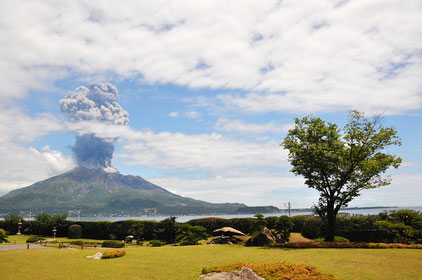The plane banked around a cross set into a verdant mountain edge as we descended toward the southern tip of Kyūshu. The temperature rose five degrees from what we were accustomed to in Tokyo, heaving the humidity up by about 50% on the way. The forty-minute bus ride from the airport to Chūō Eki-mae dove through mountainsides so lush they looked as if they’d just been scooped out by God’s trowel, punctuated by forested hills that crashed like whales through an ocean of green.
Capital of Kyushu’s southernmost prefecture, Kagoshima is like Hiroshima Lite, yet with a sense of pride and importance you will find nowhere else in Japan.
Kagoshima was the center of what was once known as the Satsuma Domain, second in wealth only to the gold-producing Kaga Domain of present-day Ishikawa, and the only realm of feudal Japan to claim a conquered nation as a vassal state (Ryūkyū, which includes what is now Okinawa).
While Kaga was tied to Shogunal authority, Satsuma effectively operated as an independent nation. It was Kagoshima that first welcomed missionary Francis Xavier in 1549, and Kagoshima that later formed the heart of Japan’s industrial revolution, having defied the Tokugawa’s closed-country edict to send seventeen students abroad in 1865. While Edo folded before Admiral Perry’s gunboat diplomacy in 1854, Kagoshima gave as good as it got during the British bombardment of the city in 1862, leading the British to tilt their favor toward the Satsuma Domain and away from French-influenced Edo.
Coupled with Chōshū (present-day Yamaguchi), technologically superior Satsuma humiliated Shogunal forces in the failed Second Chōshū expedition of 1866, then went on to lead the 1868 Meiji Restoration that laid the foundations of modern Japan. The leader of Satsuma’s forces, Saigo Takamori, returned victorious only to rebel against the Meiji Restoration itself in 1877, marking the final military rebellion in Japan.
Kagoshima was also the birthplace of Tōgō Heihachirō, who, after reputedly operating one of the cannons during the bombardment of Kagoshima, went on to lead the new Japanese navy to annihilate both Russia’s Far East and Baltic fleets in the 1904-1905 Russo-Japanese War, earning him the title ‘the Nelson of the East.’
Sakurajima
Kagoshimans may well have developed their indomitable spirit by spending every second face-to-face with one of the most active volcanoes on Earth. 1117 m in height and with a circumference of 50 km, Sakurajima is just 3.5 km away from Kagoshima Port across Kinkō Bay.
Sakurajima last experienced a major eruption in 1914, when lava flows caused the former island to merge with the Osumi Peninsula. While this was the last time lava was extruded, the volcano has been constantly active since 1955, with nearly 1000 minor eruptions of ash and steam every year. Regardless, Sakurajima is home to three schools and several hotels, while the volcanic soil produces giant radishes and miniature oranges that are used to produce a 35%-alcohol version of shōchū. In concession to the giant piece of explosive geography on which they live, the denizens of Sakurajima have built a massive series of pachinko-style lava levees, a collection of strategically-placed concrete hutches, and roofs to keep the ash off local graves.
Many restaurants in Kagoshima offer yōganyaki: they give you a carved block of lava to cook your meat on, which, when heated, is claimed to produce less smoke than a traditional yakiniku shichirin. People in Kagoshima don’t just laugh in the face of death—they grill their dinner on the edge of his scythe.
While kurobuta (black pork) is Kagoshima’s famous dish, every single piece of food we ordered in the city was ridiculously delicious. The Tenmonkan area is full of bars and restaurants, and home to an area simply called ‘Gourmet Street.’
Sengan-en
Built in 1658, Sengan-en was the villa of the Shimadzu clan, lords of the Satsuma Domain. In the 1850s, it was also the site of the largest complex of factories in the East. Producing everything from cannons to glassware, this factory—now a museum—was the literal birthplace of Japan’s industrial revolution.
A path into the mountains behind the villa offers a great view of the bay, though it seemed that we were the first ones to take it in some time. During our 3.5-hour bus tour around Sakurajima the day before, the guide noted that the mountain had been oddly quiet since June 2nd. While we were at Sengan-en, a plume of black smoke emerged from volcano in the bay, eventually rising about 3 km into the sky. While we wondered whether it was time to take shelter, an announcement came over the loudspeakers placidly announcing prime evidence of the seven colors of Sakurajima before us, and that was all.
The bus from the airport to Chūō Eki-mae, the center of town, costs ¥1200. Trams in Kagoshima charge a flat rate of ¥160. Tours of Sakurajima leave bus stop #8 at Chūō Eki twice daily, and cost ¥2200, including the ferry fee and a free one-way pass for the City View Bus (normally ¥180).






























Write a comment